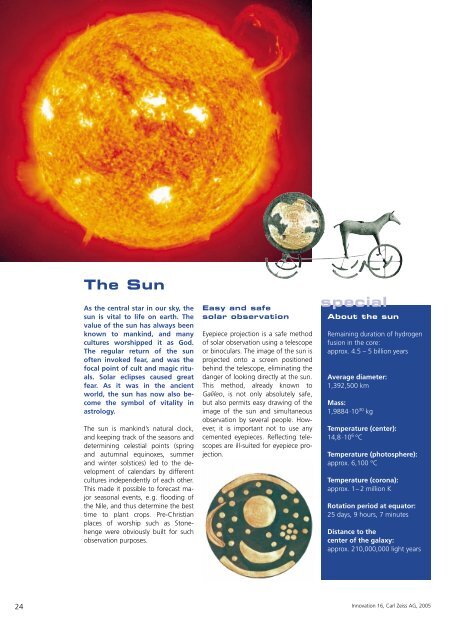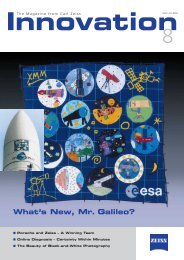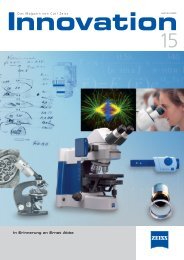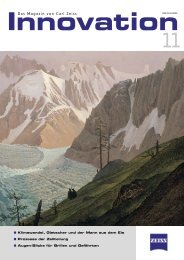Download PDF - Carl Zeiss
Download PDF - Carl Zeiss
Download PDF - Carl Zeiss
Create successful ePaper yourself
Turn your PDF publications into a flip-book with our unique Google optimized e-Paper software.
24<br />
The Sun<br />
As the central star in our sky, the<br />
sun is vital to life on earth. The<br />
value of the sun has always been<br />
known to mankind, and many<br />
cultures worshipped it as God.<br />
The regular return of the sun<br />
often invoked fear, and was the<br />
focal point of cult and magic rituals.<br />
Solar eclipses caused great<br />
fear. As it was in the ancient<br />
world, the sun has now also become<br />
the symbol of vitality in<br />
astrology.<br />
The sun is mankind’s natural clock,<br />
and keeping track of the seasons and<br />
determining celestial points (spring<br />
and autumnal equinoxes, summer<br />
and winter solstices) led to the development<br />
of calendars by different<br />
cultures independently of each other.<br />
This made it possible to forecast major<br />
seasonal events, e.g. flooding of<br />
the Nile, and thus determine the best<br />
time to plant crops. Pre-Christian<br />
places of worship such as Stonehenge<br />
were obviously built for such<br />
observation purposes.<br />
Easy and safe<br />
solar observation<br />
Eyepiece projection is a safe method<br />
of solar observation using a telescope<br />
or binoculars. The image of the sun is<br />
projected onto a screen positioned<br />
behind the telescope, eliminating the<br />
danger of looking directly at the sun.<br />
This method, already known to<br />
Galileo, is not only absolutely safe,<br />
but also permits easy drawing of the<br />
image of the sun and simultaneous<br />
observation by several people. However,<br />
it is important not to use any<br />
cemented eyepieces. Reflecting telescopes<br />
are ill-suited for eyepiece projection.<br />
special<br />
About the sun<br />
Remaining duration of hydrogen<br />
fusion in the core:<br />
approx. 4.5 – 5 billion years<br />
Average diameter:<br />
1,392,500 km<br />
Mass:<br />
1,9884·10 30 kg<br />
Temperature (center):<br />
14,8 ·10 6 °C<br />
Temperature (photosphere):<br />
approx. 6,100 °C<br />
Temperature (corona):<br />
approx. 1– 2 million K<br />
Rotation period at equator:<br />
25 days, 9 hours, 7 minutes<br />
Distance to the<br />
center of the galaxy:<br />
approx. 210,000,000 light years<br />
Innovation 16, <strong>Carl</strong> <strong>Zeiss</strong> AG, 2005


